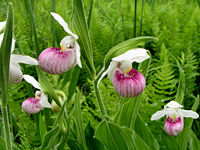Plant (organism)
| Plantae | ||||
|---|---|---|---|---|
 Cypripedium reginae
| ||||
| Scientific classification | ||||
| ||||
| Divisions | ||||
The green plants (from the Latin planta, meaning "sprout") are those organisms classified into the kingdom Plantae. Descending from a single common ancestor, the plants take up a large portion of life—with estimates exceeding 285,000 species—and include many familiar and ubiquitous species including trees, shrubs, cacti, grasses, herbs, ferns, mosses, and green algae. Plants share certain characteristics—unlike animals and fungi, they do not voluntarily move, typically growing in a permanent site, passively absorbing nutrients and energy from their environment. In terms of both their total mass and their importance to other organisms, the green plants dominate ecosystems in both land and freshwater. By harnessing sunlight, they act as the primary sources of energy and food for all life in those ecosystems: green algae in freshwater and land plants on the land.
Usage of the term
The term "plant" has gone through several definitions along history. Plants, which do not move, were distinguished from animals, which do move, by Aristotle in his works on metaphysics and logic. Aristotle continued to influence classification of plants all the way to Carl Linnaeus, who divided all life into the two kingdoms Vegetabilia (or Plantae) and Animalia. Fungi and protists were originally grouped into Plantae, but they were moved into their own kingdoms when it became clear that they were very different from plants.
At this time, the algae were reclassified as protists, which included a hodgepodge of many unrelated aquatic organisms that, like land plants, could capture energy from sunlight using photosynthesis but had developed it independently. The many varieties of seaweed, for instance, may resemble land plants but are divided among the green, red, and brown algae.
Most of the algae are still considered separate from the land plants today. The green algae, however, have recently been placed back into the Plantae, as they form a clade with the land plants (meaning the green algae and land plants are descended from one common ancestor).
Origin and phylogeny
Despite Phylogeny changing many of the concepts of how plants should be classified and what divisions remain, currently plants are informally divided among four main groups called; green algae, about 8.000 species; non vascular plants, or Bryophytes, circa 20.000 species; the ferns and horsetails, or Pteridophytes, around 12,000; and seed plants, that is the largest group with 260,000 estimated species. These are split in twelve total divisions:
- Chlorophyta: part of green algae
- Charophyta: the rest of green algae
- Marchantiophyta: liverworts
- Anthocerotophyta: hornworts
- Bryophyta: mosses
- Lycopodiophyta: club mosses
- Pteridophyta: ferns
- Cycadophyta: cycads
- Ginkgophyta: ginkgo
- Pinophyta: conifers
- Gnetophyta: gnetophytes
- Magnoliophyta: flowering plants